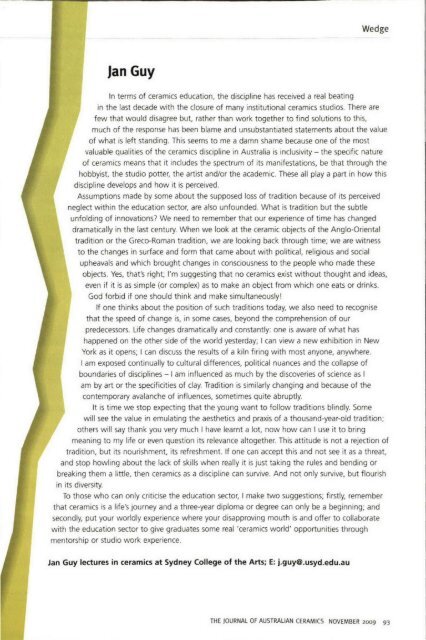The Journal of Australian Ceramics Vol 48 No 3 November 2009
Create successful ePaper yourself
Turn your PDF publications into a flip-book with our unique Google optimized e-Paper software.
Wedge<br />
Jan Guy<br />
In terms <strong>of</strong> ceramics education, the discipline has received a real beating<br />
in the last decade w ith the closure <strong>of</strong> many institutional ceramics studios. <strong>The</strong>re are<br />
few that would disagree but, rather than work together to find solutions to this,<br />
much <strong>of</strong> the response has been blame and unsubstantiated statements about the value<br />
<strong>of</strong> what is left standing. This seems to me a damn shame because one <strong>of</strong> the most<br />
valuable qualities <strong>of</strong> the ceramics discipline in Australia is inclusivity - the specific nature<br />
<strong>of</strong> ceramics means that it includes the spectrum <strong>of</strong> its manifestations, be that through the<br />
hobbyist, the studio potter, the artist and/or the academic. <strong>The</strong>se all playa part in how this<br />
discipline develops and how it is perceived.<br />
Assumptions made by some about the supposed loss <strong>of</strong> tradition because <strong>of</strong> its perceived<br />
neglect within the education sector, are also unfounded. What is tradition but the subtle<br />
unfolding <strong>of</strong> innovations' We need to remember that our experience <strong>of</strong> time has changed<br />
dramatically in the last century. When we look at the ceramic objects <strong>of</strong> the Anglo-Oriental<br />
tradition or the Greco-Roman tradition, we are looking back through time; we are witness<br />
to the changes in surface and form that came about with political, religious and social<br />
upheavals and which brought changes in consciousness to the people who made these<br />
objects. Yes. that's right; I'm suggesting that no ceramics exist without thought and ideas,<br />
even if it is as simple (or complex) as to make an object from which one eats or drinks.<br />
God forbid if one should think and make simultaneously!<br />
If one thinks about the position <strong>of</strong> such traditions today. we also need to recognise<br />
that the speed <strong>of</strong> change is, in some cases. beyond the comprehension <strong>of</strong> our<br />
predecessors. Life changes dramatically and constantly: one is aware <strong>of</strong> what has<br />
happened on the other side <strong>of</strong> the world yesterday; I can view a new exh ibition in New<br />
York as it opens; I can discuss the results <strong>of</strong> a kiln firing with most anyone, anywhere.<br />
I am exposed continually to cultural differences, political nuances and the collapse <strong>of</strong><br />
boundaries <strong>of</strong> disciplines - I am influenced as much by the discoveries <strong>of</strong> science as I<br />
am by art or the specificities <strong>of</strong> clay. Tradition is similarly changing and because <strong>of</strong> the<br />
contemporary avalanche <strong>of</strong> influences. sometimes quite abruptly.<br />
It is time we stop expecting that the young want to follow traditions blindly. Some<br />
will see the value in emulating the aesthetics and praxis <strong>of</strong> a thousand-year-old tradition;<br />
others will say thank you very much I have learnt a lot, now how can I use it to bring<br />
meaning to my life or even question its relevance altogether. This attitude is not a rejection <strong>of</strong><br />
tradition, but its nourishment, its refreshment. If one can accept this and not see it as a threat,<br />
and stop howling about the lack <strong>of</strong> skills when really it is just taking the rules and bending or<br />
breaking them a little, then ceramics as a discipline can survive. And not only survive, but flourish<br />
in its diversity.<br />
To those who can only criticise the education sector, I make two suggestions; firstly, remember<br />
that ceramics is a life 's journey and a three-year diploma or degree can only be a beginning; and<br />
secondly, put your worldly experience where your disapproving mouth is and <strong>of</strong>fer to collaborate<br />
w ith the education sector to give graduates some real 'ceramics world' opportunities through<br />
mentorship or studio work experience.<br />
Jan Guy lectures in ceramics at Sydney College <strong>of</strong> the Arts; E: j.guy@.usyd.edu.au<br />
THE JOURNAL OF AUSTRALIAN CERAMICS NOVEMBER <strong>2009</strong> 93


















